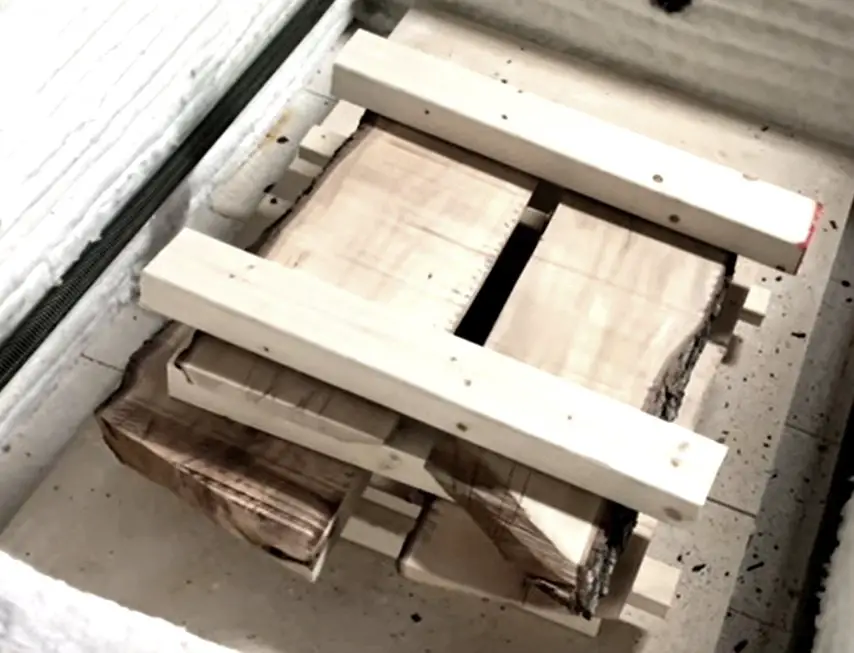
The following is a glossary of terms related to the drying of wood and their meanings.
Contents
- The Glossary
- Air dried
- Air drying
- Average moisture content of a load
- Bound moisture
- Casehardening
- Check
- Collapse
- Conditioning treatment
- Drying defect
- Distortion (warp)
- Drying schedule
- Equilibrium moisture content (emc)
- Free moisture
- Fibre saturation point
- Green
- Heat pump kiln
- Honeycombing
- Hygrometer
- Kiln
- Kiln dried
- Kiln drying
- Moisture content
- Movement
- Moisture gradient
- Plain-sawn timber
- Permanent set
- Quarter-sawn timber
- Reconditioning treatment
- Refractory
- Relative humidity
- Sample
- Shrinkage
- Shake
- Split
- Steaming treatment
- Test section
The Glossary
Air dried
Wood which has been subjected to air drying.
Air dried wood may be expected to have moisture content in the range 17-23% depending upon climate.
Air drying
A method of drying timber by exposure to natural atmospheric conditions.
Average moisture content of a load
An estimated value calculated by averaging moisture content values obtained from several samples in the load.
Bound moisture
Moisture which is closely bound to the cell wall constituents of wood.
Casehardening
A drying defect characterized by the presence of compression stresses in the outer zone and tensile stresses in the core.
It occurs when rapid drying has caused permanent set of the outer zones of a piece of wood.
Check
A drying defect which occurs when tensile stresses cause the wood fibers to separate and form cracks.
Checks are cracks visible at the surface but which do not extend across a piece.
Collapse
Excessive and often uneven shrinkage during drying caused by the collapse or buckling of the cell walls.
Conditioning treatment
A treatment applied to equalize the moisture content of wood to a particular value.
Drying defect
A feature developed during drying which may decrease the value of a piece of timber.
Distortion (warp)
A drying defect caused by the differential shrinkage along the three axes of a piece of wood.
Distortion may take the form of cup, bow, twist, spring or diamonding.
Drying schedule
A sequence of kiln conditions which result in a gradual decrease in moisture content of the wood.
Twelve standard schedules varying from mild to severe are recognized.
Timber species are assigned to the schedule which will achieve the fastest drying with an acceptably low level of degrade.
Equilibrium moisture content (emc)
This is the moisture content that a piece of wood will achieve when it is in equilibrium with the surrounding air.
It is a variable value which is governed principally by the temperature and relative humidity of the air.
Free moisture
Moisture which is present in the cell cavities of wood.
Fibre saturation point
The theoretical point at which wood no longer contains any free moisture but still contains all its bound moisture.
Green
Wood which still contains its original free moisture.
Heat pump kiln
A kiln which recycles latent heat from the moist air produced during the drying process and from ambient air.
Honeycombing
A drying defect which occurs when tensile stress in the core results in the formation of internal cavities.
Hygrometer
An instrument for measuring the humidity of air.
Kiln
A closed chamber in which the air temperature, humidity and movement can be adjusted to control the drying of timber.
Kiln dried
Wood which has been dried in a kiln, often to a specified moisture content.
Kiln drying
A method of drying in which air temperature, humidity and movement can be adjusted to control the loss of moisture from wood and enable particular or specified moisture contents to be achieved.
Moisture content
This is the total amount of water contained in a piece of wood.
In timber technology, moisture content is expressed as a percentage of the oven dry weight.
Moisture content determinations with the oven drying method give an average moisture content for the piece.
Actual moisture contents at different locations within this piece may vary quite considerably depending on the moisture gradient and drying characteristics of the particular timber species.
Movement
The extent of expansion and contraction which occurs with dried wood as its moisture content responds to change in relative humidity in service.
Movement is expressed as the dimensional change which occurs at 25°C when the relative humidity is increased from 60 to 90%.
Moisture gradient
A progressive decrease (or increase) in moisture content between the core and the surface of a piece of wood.
Plain-sawn timber
Timber converted so that the growth rings meet the face in any part at an angle of less than 45°.
Permanent set
A change in the properties of wood which can occur during drying when stressing exceeds the elastic limit.
Permanent set prevents normal shrinkage of the timber and can lead to more obvious defects such as casehardening and honeycombing.
Quarter-sawn timber
Timber converted so that the growth rings meet the face at an angle of not less than 45°.
Reconditioning treatment
A high temperature/high relative humidity (100%) treatment applied after drying to restore the shape of collapsed or distorted wood.
Refractory
In timber drying this term is used to indicate high resistance to moisture loss during drying.
Relative humidity
At a given temperature this is the amount of moisture in air as a percentage of the maximum moisture carrying capacity of the air, i.e. the water vapor pressure as a percentage of the saturated water vapor pressure.
Sample
In timber drying the term ‘sample’ refers to just one of the several pieces of wood which are used to monitor the drying of a particular load.
Shrinkage
The reduction in size of a piece of wood which occurs during drying.
Sometimes shrinkage is expressed as the percentage reduction in size which occurs along a particular axis when the moisture content of a piece of wood is decreased from green to 12%.
Shake
Separation or breakage of the wood fibers caused by stresses in the standing tree or by felling and handling of the log.
It is not caused by shrinkage during drying.
Split
A drying defect which occurs when tensile stresses cause the wood fibers to separate and form cracks.
Splits are cracks which extend across a piece.
Steaming treatment
A treatment carried out in steam at 100°C (or above) before commencing a drying schedule.
Test section
A small cross section taken from a sample and used to determine moisture content, moisture distribution, or the presence of casehardening.
